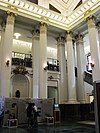Taiwan National Museum
 Museum logo |
|
| Data | |
|---|---|
| place | District Zhongzheng , Taipei, Taiwan |
| Art |
Culture and Natural History Museum
|
| architect | Nomura Ichiro (野村 一郎), Eiichi Araki (新 木 栄 吉) |
| opening | October 24, 1908 |
| operator |
Ministry of Culture of Taiwan
|
| management |
Hong Shiyou (洪世佑)
|
| Website | |
The Taiwan National Museum ( Chinese 國立 台灣 博物館 , Pinyin Guólì Táiwān Bówùguǎn , English National Taiwan Museum ) in Taipei is the largest and oldest museum in the Republic of China on Taiwan .
history
The museum opened on October 24, 1908, during the Japanese rule of Taiwan . The reason for the establishment of the museum was the completion of the railway line (today's Western Line ) from Taihoku (today Taipei) in the north of Taiwan to Takao (today Kaohsiung ) in the south. Initially, the museum acted under the name “Museum of the Governor's Office ” and had more than 10,000 exhibits in its fund. A new representative museum building was erected from 1913 to 1915. The museum was then named Gouverneur Gentarō Civil Governor Gotō Memorial Museum ( Japanese Taiwan 玉 総 督 後 藤 民政 長官 記念 館) in honor of the fourth governor of Taiwan, Kodama Gentarō, who was in office between 1898 and 1906, and the civil governor Gotō Shimpei .
After the end of Japanese rule (1945) and the establishment of the Republic of China in Taiwan (1949), the museum came under the jurisdiction of the Department of Education of the Taiwan Province and was named Taiwan Provincial Museum (臺灣 省立 博物館). Between 1961 and 1964 the museum was closed due to extensive renovation work. In 1999 it was subordinated to the Council for Cultural Affairs ( Chinese 文化 建設 委員會 , Pinyin Wénhuà Jiànshè Wěiyuánhuì ) - an authority that was located directly at the Executive Yuan - and renamed the Taiwan National Museum . The change in responsibilities also resulted in improved financial resources, so that renovation work could begin and research projects could be intensified.
Exhibitions
The museum is devoted to a wide range of topics from art and natural history with a focus on Taiwan. A large part of the inventory is made up of ethnographic objects from the indigenous people of Taiwan , most of which were collected by Japanese ethnologists and researchers before 1945. There are also objects from the history of Taiwan and some other countries. The natural history collections include fossils, animal specimens, butterfly collections, etc. The museum has not remained unaffected by the political changes that have taken place in Taiwan since the mid-1980s. Whereas in the past, during the autocratic rule of the Kuomintang was emphasized in the exhibitions belonging to Taiwan for the greater Chinese culture, shifted up, especially after Chen Shui-bian in the 2000 election had been elected president, the topics and the exhibitions were Taiwan more centered. For example, in 2003 there was a major exhibition, Ilha Formosa , which was dedicated to Taiwan's early colonial history, and an exhibition in 2007 had Taiwan on maps on the subject.
Museum building
The museum building is one of the most important buildings from the Japanese colonial era in Taiwan and was declared a “ National Historic Site ” by the Taiwanese Ministry of the Interior in 1998 .
The building was built according to the plans of the Japanese architects Nomura Ichiro (野村 一郎) and Eiichi Araki (新 木 栄 吉) in the style of eclecticism . The scaffolding structure consists of reinforced concrete, supplemented by load-bearing brick masonry, which was a very modern construction method for Taiwan at the time. The building has three floors and the entrance is on the second floor. Originally, only the second and third floors, which have a higher ceiling height, were intended as exhibition rooms, while the administration etc. of the museum were to be housed on the first floor. The six Doric columns and the portico of the entrance portal are kept in the classical Greek style. The 16 meter high main or entrance hall is framed by 32 Corinthian columns, vaulted by a pantheon- like dome and is flanked by two exhibition halls on the sides. The windows and the main hall are largely designed in the Renaissance style. Bronze statues of the eponymous governors Kodama and Gotō are located in two niches in the entrance hall. For the design of the glass windows and the glass mosaics on the ceiling, motifs from the two family coats of arms were chosen. The interior of the museum is lavishly lined with marble and cypress wood and copper tiles were used for the ceiling paneling .
Web links
Individual evidence
- ↑ There are other transcriptions in use: National Taiwan Museum , Taiwan National Museum , and others; the name Taiwan National Museum was chosen here in order to remain congruent with the other national museums of Taiwan.
- ↑ a b National Taiwan Museum. (No longer available online.) Museum website, archived from the original on November 23, 2017 ; accessed on January 23, 2018 (English). Info: The archive link was inserted automatically and has not yet been checked. Please check the original and archive link according to the instructions and then remove this notice.
- ↑ About us. Ministry of Culture, accessed January 23, 2018 .
- ↑ 典藏 ("Collection"). Museum website, accessed January 25, 2018 (Chinese).
- ^ Edwards Vickers: History, Identity, and the Politics of Taiwan's Museums: Reflections on the DPP-KMT Transition . In: Center d'étude français sur la Chine contemporaine (ed.): China Perspectives . September 15, 2010, ISSN 1996-4617 (English, online ).






